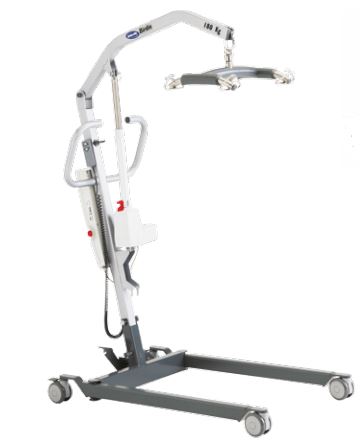Which Hoist?
A residential hoist or ceiling lift can help people who have difficulty safely moving themselves or others in or out of bed, or in or out of a bathtub. Consistent with the philosophy of Universal Design, it takes little physical effort to use a residential hoist or ceiling lift to move people from one position to another or from one place to another.
Residential hoists and ceiling lifts help many people — for instance, seniors who want to remain in their own homes despite changes in their mobility, strength or agility; and parents of children with a disability who can no longer lift their children. A residential hoist or ceiling lift can allow a spouse, partner, parent or caregiver to help with transfers, which can help maintain independence and allow people to stay in their own homes.
What are Hoists and Lifts?
A hoist is a mechanical lifting device that can lift someone from a seated position and transfer them to another location, such as a bed, a seat or a bathtub. Some hoists can move horizontally between areas within a room or between rooms.
A ceiling lift is the commonest term for a type of hoist that consists of a hoisting unit mounted to a track in the ceiling. This type of hoist allows a person to be lifted and moved across a room, or between rooms.
What Types of Hoists are Available?
There are three types of residential hoisting devices:
- Wheeled hoists
- Stationary hoists
- Ceiling lifts
Wheeled Hoist
A wheeled hoist is free-standing equipment that supports the person being moved in a sling or harness that is suspended from a cantilevered arm. The sling is placed around the person while he or she is seated or lying down. The person is then hoisted up, the hoist is wheeled to the new location and the person is lowered.
One of the first things to consider is the amount of manoeuvring space a wheeled hoist needs. The wheeled base of the hoist must be wide enough to remain stable with the person in it. Consequently, wheeled hoists require a wide and unobstructed path of travel — usually at least 1,100 mm (43 1/2 in.) and possibly more if turns are required.
Another design consideration is clear space under furniture and fixtures, to accommodate the frame of the hoist. If a wheeled hoist is to be used for transfers in and out of a bathtub, the bathtub should have legs or be raised from the floor the hoist frame will fit under the bathtub.
Stationary Hoist
Stationary hoists are mounted to the floor or a wall. Although the base of the hoist is fixed, a support arm pivots to transfer the person sideways. Stationary hoists use a sling or harness similar to that of a wheeled hoist.
The primary design consideration for a stationary hoist is the structural strength of the floor or wall it is attached to. The advice of a structural engineer is a must.
Other considerations include the arc of the hoist swing (ensure it reaches the necessary elements) and making sure that clear space is available for the wheelchair during the transfer to and from the hoist.
Ceiling lift
A ceiling lift is a hoist that is mounted on a ceiling. A ceiling lift is usually electrically powered, but there are manual units. An electric hoist with a sling system is attached to a ceiling track and the person is lifted in the sling and moved along the ceiling track.
The primary consideration in choosing and installing a track-mounted ceiling lift is the structural strength of the supports in the ceiling. The advice of a structural engineer is a must. You must also provide a clear path of travel along the route of the track, particularly at door frames for a system that connects two or more rooms.
Ceiling tracks can be provided in a variety of locations — most electric hoists can be manually moved from one location to another. Some track systems also incorporate a turntable, allowing the hoist to move easily from one track system to another. Turntables can be manual or electric.
Consider a hoist or ceiling lift when the person being moved becomes too heavy or too large to be moved safely manually. One person can easily and safely assist with transfers if a mechanical hoist is used for the transfer.
What About Maintenance?
Hoists and ceiling lifts are mechanical devices that can break down. They need regular servicing. Maintenance is generally complex and should be done by an expert. Purchasing a maintenance contract from a reputable supplier is a very good idea.
Powered units often have a standby, rechargeable battery which comes with the lift. You will eventually have to replace the battery.




